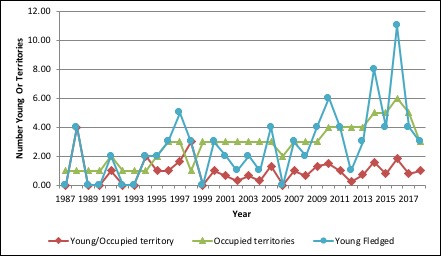Guest Blog by Sarah Hegg | Biologist – Grand Teton National Park
The American Peregrine Falcon (Falco peregrinus) is one of the Endangered Species Act’s (ESA) most remarkable success stories. Grand Teton National Park was an integral part of their recovery in the Jackson Hole area.
Peregrine Falcons are cliff-nesting raptors that mainly eat other birds. They are perhaps most famous for their speed. Biologist have clocked peregrines at speeds of up to 200 mph, speeds that rival race cars. Along with their speed, their extraordinary aerial acrobatics, rapid diving, and graceful soaring make them one of the most impressive birds to watch. The lower elevations of the major canyons in Grand Teton National Park provide extensive opportunities for cliff-nesting and diverse habitats for foraging.
With the introduction and use of the pesticide DDT in the 1940s, many bird species, especially predatory raptors, experienced drastic declines throughout North America. Peregrine Falcons were among the birds most affected by DDT and its toxins. It is believed that peregrines were almost completely extirpated within the Greater Yellowstone Ecosystem by the 1960s.
Peregrine Falcons were listed under the ESA as endangered in 1970. The restriction and banning of DDT, along with other organochlorine pesticides within North America, in combination with habitat protections and a reintroduction program helped contribute to the recovery of Peregrine Falcon populations. In 1980, efforts to reintroduce Peregrine Falcons to Yellowstone and Grand Teton National Parks were initiated locally by The Peregrine Fund, the Wyoming Game and Fish Department, and the U.S. Forest Service. These local efforts were in conjunction with similar efforts elsewhere in the Greater Yellowstone Area and western United States.
To reintroduce Peregrines in the park, large hack boxes (5’ x 4’ x 3’) were built using plywood sides, a barred metal front and a gravel floor. These hack boxes were placed at several sites within the park and Jackson Hole. Between 1980 and 1986, 52 fledgling falcons were released at 3 different hack sites. Several captive-bred peregrine chicks were placed in the hack boxes each year and fed multiple times daily through a remote feeding chute so the young falcons could be fed without associating food with humans. When the chicks were old enough to fly, the bars on the front of the hack boxes were gradually removed. The first wild nesting attempt in the park was documented in 1987 near Glade Creek, which was also the location of the first successful wild breeding occurrence in 1988.
Peregrine Falcon populations have slowly recovered throughout North America and were removed from the ESA in 1999. Each year since 1987, park biologists conduct surveys of known and potential peregrine territories to document the number of occupied territories and their reproductive success. While the number of territories has gradually increased, reproductive success is still fairly low and can vary greatly from year to year.
One of the new territories established was in lower Cascade Canyon in 2010. This eyrie (the name for a peregrine nest) is located near Baxter’s Pinnacle, a popular rock climbing route. This area is thought to have been historically occupied in the early 1900s. Peregrine falcons are very sensitive to human disturbance. They will abandon their nest to defend their territory, which can lead to nest failure and low reproductive success. Since 2011, the park has established a closure for the Baxter’s Pinnacle climbing route and its descent gully area each year when and if biologists confirm the territory is occupied (typically sometime in April) and lasts until the pair fails or the young successfully fledge (generally mid-August). In addition to protecting young Peregrines, this closure also helps to protect climbers. Peregrine Falcons are fiercely territorial and aggressive birds, especially while nesting and incubating eggs. They become even more protective after their chicks hatch. The bird’s speed and aggressive territorial behavior pose a safety risk to climbers who could be knocked off the route and injured.
The Baxter’s pair have successful fledged young, six of the eight years that the territory has been closed, and is one of the most consistently successful Peregrine territories in the park. The support from the climbing community by respecting this closure area is crucial for the falcon’s continued success, and is greatly appreciated. This example of cooperation helps the park carry out its mission of preserving native wildlife and habitat while providing enjoyment and recreation opportunities.
Numbers in Grand Teton
- In 2018 park staff monitored 8 known and recently active territories, 3 of which were occupied.
- The 32-year historical average for successful occupied territories is 47%, and the recent 10-year average is 60%.
- The 32-year historical average productivity is 1.53 young per breeding pair, while the recent 10-year average is 1.77 young per breeding territory.
- The maximum numbers of peregrine territories occupied is 6, and the maximum number of young fledged is 11, both occurring in 2016.
Identification
- Slightly smaller than a crow
- Black/dark gray “helmet” and a black wedge below the eye
- Uniformly gray under its wings. (The prairie falcon, which also summers in Grand Teton, has black “armpits”)
- Long tail, pointed wings
Habitat and Behavior
- Near water, meadows and woodlands, cliffs
- Nests on large cliffs over rivers or valleys where prey is abundant
- Resident in the park March through October, when its prey—primarily songbirds and waterfowl—are abundant. Migrates to Mexico or even further south for winter
- Lays 2–4 eggs in late April to mid-May
- Chicks begin to fledge in late July or early August
- Dives at high speeds (can exceed 200 mph/320 kph) to strike prey in mid-air
Cover Photo by C. Adams

